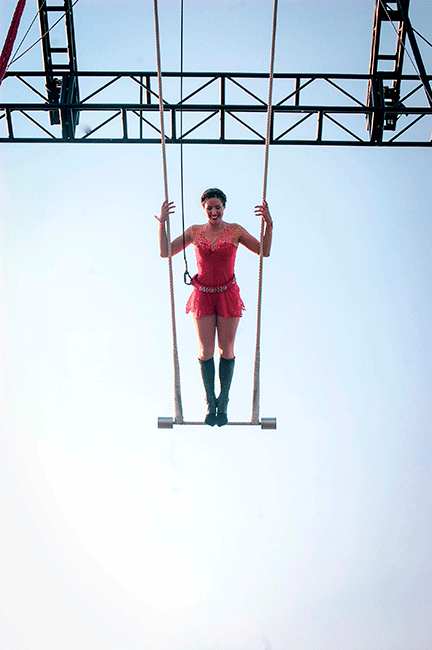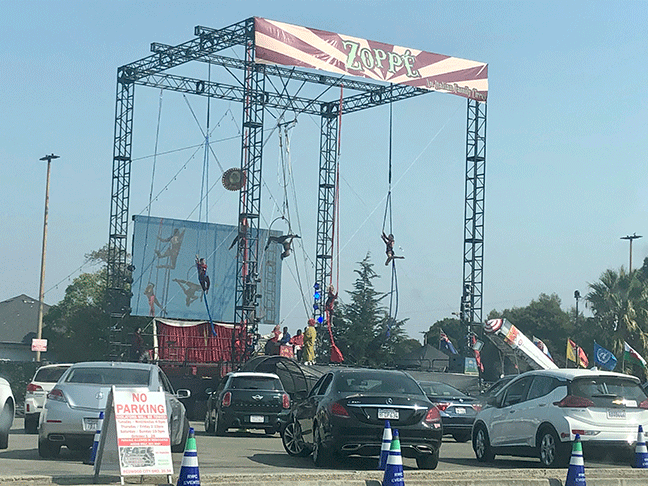
REDWOOD CITY, California — Rows of cars honked their praise for a trapeze artist and a “human cannonball” at the Zoppé Italian Family Circus’ drive-in show.
The circus has performed in Redwood City annually for the past thirteen years but shifted to a new format this time around to adapt to coronavirus public health guidelines. After debuting their drive-in show in Ventura in July, Zoppé brought it to Redwood City, where they will be performing through October 25.
The drive-in circus represents a novel way of adjusting entertainment to an era in which large, indoor crowds are forbidden. The entertainment industry has struggled during the pandemic as music, dance and theater, like the circus, have been forced to either shutter or try to support themselves with shows on Zoom. Independent entertainment venues were often the first to close due to the coronavirus and may be among the last to reopen, according to a June 2020 report from the National Independent Venue Association.
To survive the pandemic, entertainment businesses have had to get creative. Drive-in shows have offered a way to keep safer live options available, since attendees in their cars can distance from members of other households. Drive-in movies proliferated after theaters closed, drive-in live concerts have cropped up across the country and Zoppé is one of a small number of circuses testing the drive-in format.
Giovanni Zoppé, the circus director, clown and a sixth-generation descendant of the founders, said that when the pandemic began, he returned to an idea he first had a year earlier: a drive-in circus.
“We’re always trying to find new things,” Zoppé said. “But I couldn’t figure out how to get enough cars in order to make enough revenue to support the show.” So he temporarily let the idea go.
“Then when the pandemic hit, I was like, ‘We gotta revisit this,’” Zoppé said.
To allow for more viewers and increased ticket sales, Zoppé added an LED video screen that makes the show visible from a distance by broadcasting zoomed-in live footage. The screen took the Redwood City maximum audience size from around 20 cars to 74. While employees changeover the stage setup between acts, it also displays short videos about Zoppé Italian Family Circus history and interviews with its performers.
As audience members’ cars entered the main parking lot at the Port of Redwood City just before noon on Oct. 3, ushers directed them to form several concentric semicircles facing an elevated stage. Parking lot attendants told viewers to tune their car radios to 103.1 FM to hear the announcer and music.
Audio also required rethinking when the show pivoted to drive-in form. Zoppé brainstormed ways to encourage interaction despite the windshields standing between audience members and performers.
“I need to connect with the audience,” Zoppé said. “If there’s not a spiritual connection, the clown can’t do his job.”
He tried to bridge the gap and evoke emotion by encouraging audience participation. At one point, Zoppé held up a small horn and invited drivers to honk along with him to a Strauss tune. The audience caught on and honked loudly in response to their favorite feats throughout the show.
The aerial silks and trapeze acts drew an enthusiastic response, as did a trio of acrobats from Moscow and another trio of tumblers from Chicago.
Attendees said they were glad to experience the circus again, whatever the setup. Although the October 3 show was about two-thirds full, Zoppé marketing director Jeanette Prince said overall revenue this fall has been on par with past years. Audience sizes have been increasing as word spreads about the performance, Prince said.
Tickets cost between $84 and $175 per car, with front-and-center spots by the stage commanding a premium.
Kurt Gonzales said he and his family have seen Zoppé productions every year they have been in Redwood City.
“They had some new acts this year,” Gonzales said. “The human cannonball was definitely new. I think they were a little limited on what they could do with horses and dog shows and that kind of stuff, but they chose good acts that you can visually watch. Everybody can see up high.”

(Jasmine Kerber/Peninsula Press)
Trapeze artist Disa Carneol said she was relieved to learn that the drive-in circus would allow her to keep her job.
“When the pandemic hit, we didn’t know if we were going to get on the road at all this year,” Carneol said. But even when she found out the show would go on, she wondered whether she could connect with the audience.
“It’s harder when you don’t know what the audience’s reactions are,” Carneol said. “Normally the lights are such that I can’t really see out of my own little bubble in the air, but you can hear them. I do a trick and hear the audience go, ‘Whoa.’”
Hearing the chorus of horns reassured her that her flights through the air continued to entertain viewers in their cars.
Beyond finding a way to safely perform and make a living, Zoppé, Carneol and other circus performers said their shows give them a sense of purpose.
“We all need to eat,” Zoppé said. “We all need income to survive. But performing with our heart and giving our soul to our audience, we all have to do that as.
